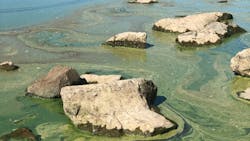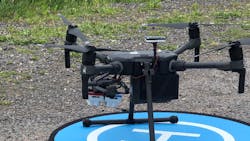Syracuse Uses Uncrewed Aircraft and Vision System to Monitor Harmful Algae
Syracuse, NY, is experimenting with using uncrewed aircraft equipped with vision systems to monitor outbreaks of harmful algal blooms (HABs) in nearby Skaneateles Lake, one of New York’s Finger Lakes and the city’s primary water source.
The goal is to spot HABs early, so they are easier to eradicate using methods that are more environmentally friendly than chemicals. The pilot project is one of numerous projects funded by Empire State Development, a New York government agency, to encourage the use of smart-city technologies.
Challenges in Detecting Algae
Algae blooms can be difficult to spot in early stages, which is why Syracuse officials think the combination of uncrewed aircraft and vision technology could be helpful, according to a project brief city officials created.
Algae usually appear on the surface of the water early in the day and then descend underwater as the outdoor temperature rises. Driven by wind, the blooms also can move over large distances in a body of water.
Traditional methods of detecting the blooms typically rely on remote sensing via satellite, which can be hampered by cloud cover, and visual observation. Chemical treatments are typically used to eradicate the HABs.
NUAIR (Syracuse, NY, USA; https://nuair.org), which is overseeing the project for the city, is working with BloomOptix, (Syracuse, NY, USA; https://bloomoptix.com), a startup company that helps detect algae blooms. Eget Liber (Syracuse, NY, USA; https://eget-liber.com), another startup, also is involved in the project. The company operates uncrewed boats equipped with chemical-free, environmentally friendly technology to mitigate and/or eradicate the HABs. The treatment involves a combination of UV-C, Sonication, Ozone, and aeration.
City officials want to “understand what it would take to scale the technology to be effective at an operational level in a lake like Skaneateles Lake,” explains Dave Whitaker, chief of development for NUAIR, which promotes the use of uncrewed aircraft and manages the operations of the FAA-designated New York UAS Test Site at Griffiss International Airport (Rome, NY, USA; https://www.ocgov.net/airport).
The Detection Process
To detect the presence of algae blooms in the water, BloomOptix uses an uncrewed aircraft equipped with a multispectral camera, a MicaSense RedEdge MX Dual Camera Imaging System (Seattle, WA, USA; https://micasense.com/). The aircraft flies over the lake collecting Nadir images, meaning that the camera is facing directly downward when it captures the images. BloomOptix collects data across 10 multispectral bands in the electromagnetic spectrum and then “selects the most appropriate bands to use based on project needs. As background reflectance and color of waterbodies differs, different bands and algorithms naturally work better than others in some instances, therefore, our choice of bands and algorithms changes frequently,” says Igor Mrdjen, project and science lead for BloomOptix, a wholly owned subsidiary of Ramboll Group A/S (Copenhagen, Denmark; https://ramboll.com/).In addition to the aircraft from BloomOptix, Syracuse project officials also have access to uncrewed aircraft equipped with RGB cameras and operated by NUAIR. These aircraft have the advantage of being lighter and faster than their counterparts from BloomOptix, allowing them to cover larger geographic areas, Whitaker says.
After collecting hundreds of Nadir images, BloomOptix creates an OrthoMap, or heat map. “Through additional analysis we can color code the OrthoMap to read much like a standard heat map would, with red signifying the most intense blooms and green signifying relatively ‘clean’ water,” says Mrdjen.
To create the maps based on the images, BloomOptix uses photogrammetry software from Pix4D (Prilly, Switzerland; https://www.pix4d.com).
However, project officials cannot tell if the blooms are harmful based on the images and heat map. That assessment happens using the onshore water-testing process. BloomOptix uses several options to gather water samples for testing: by hand, uncrewed aircraft, or the company’s underwater submersible remotely operated vehicle (ROV).
Once water samples are collected and affixed to slides, BloomOptix examines them using a portable microscope from iolight (Whitchurch, UK; https://iolight.co.uk/), which can transfer data from the slides to mobile phones for further processing and analysis. BloomOptix-developed AI-based algorithms, which have been trained to recognize HABs, then process the data to identify bacteria present in the sample. Because the system is compact, it can be used onshore, eliminating the need to send samples to outside labs for testing.
Project Results
Pilot project officials in Syracuse tested the treatment technology on one HAB in the summer of 2021. However, since the bloom was close to the shore, it was spotted without the use of the uncrewed aircraft or camera.
The entire system, using the uncrewed systems for both detection and treatment, has been tested numerous times without an actual sighting of algae.
Project officials also have been thwarted at times in their efforts to detect the HABs. Because the blooms are not stationary, “we sometimes do miss them. There have been a couple times where we've seen (a bloom), then we dispatched our crew, and by the time we got there, it was gone,” Whitaker says.
Before wrapping up the project in late 2022, the team planned to remain on alert for algae blooms occurring in Skaneateles Lake between August and October 2022, peak season for HABs.
About the Author
Linda Wilson
Editor in Chief
Linda Wilson joined the team at Vision Systems Design in 2022. She has more than 25 years of experience in B2B publishing and has written for numerous publications, including Modern Healthcare, InformationWeek, Computerworld, Health Data Management, and many others. Before joining VSD, she was the senior editor at Medical Laboratory Observer, a sister publication to VSD.


